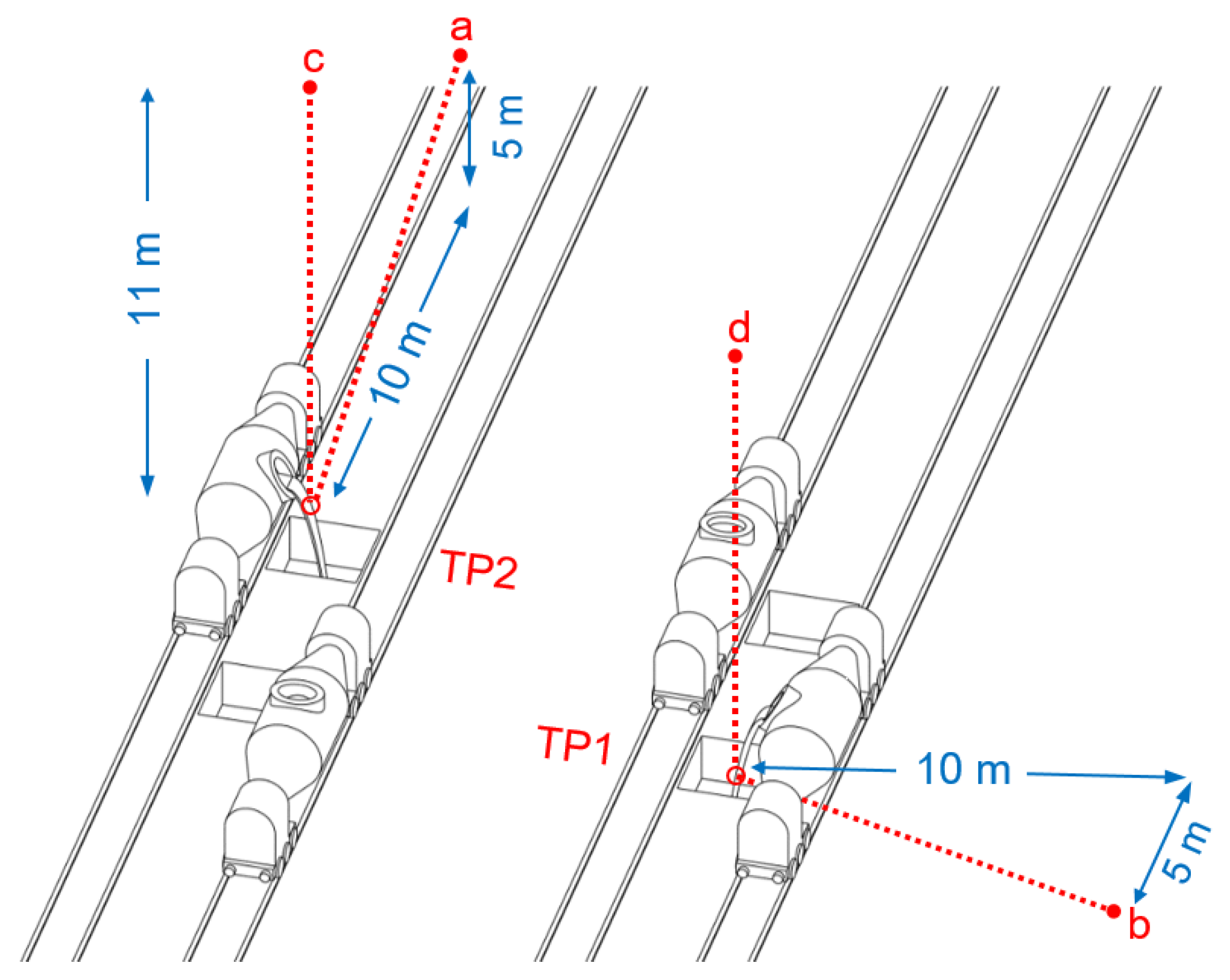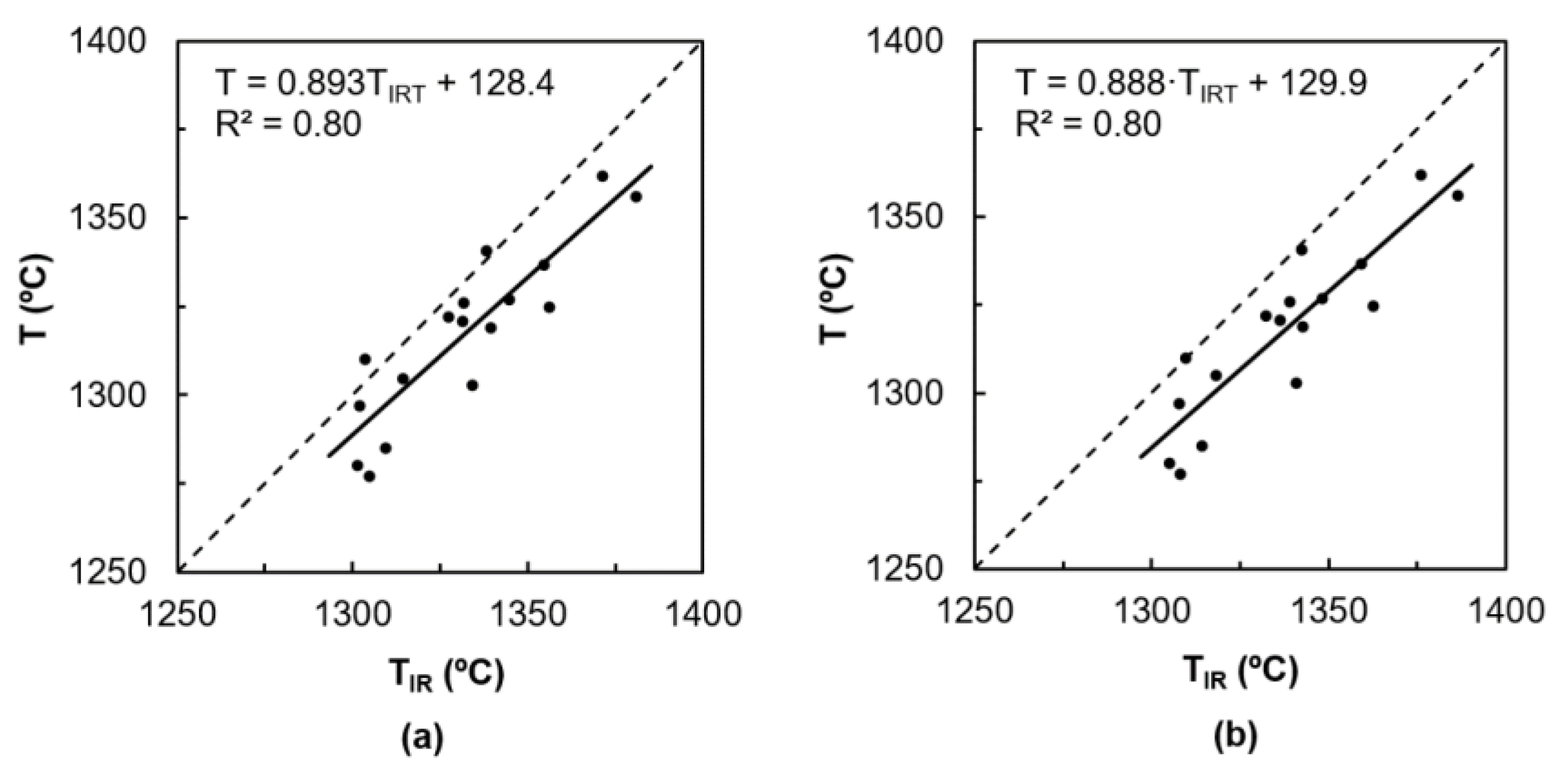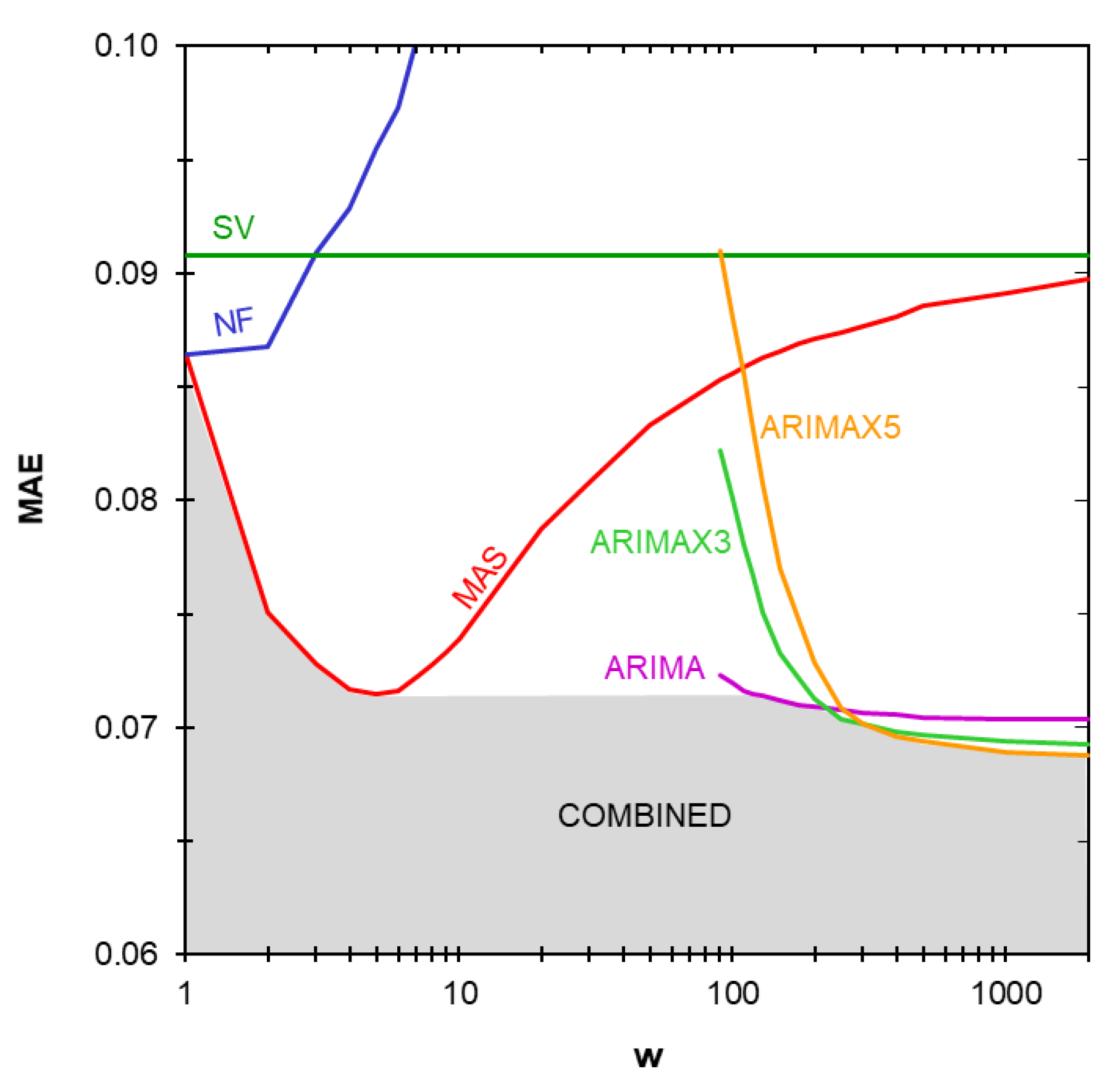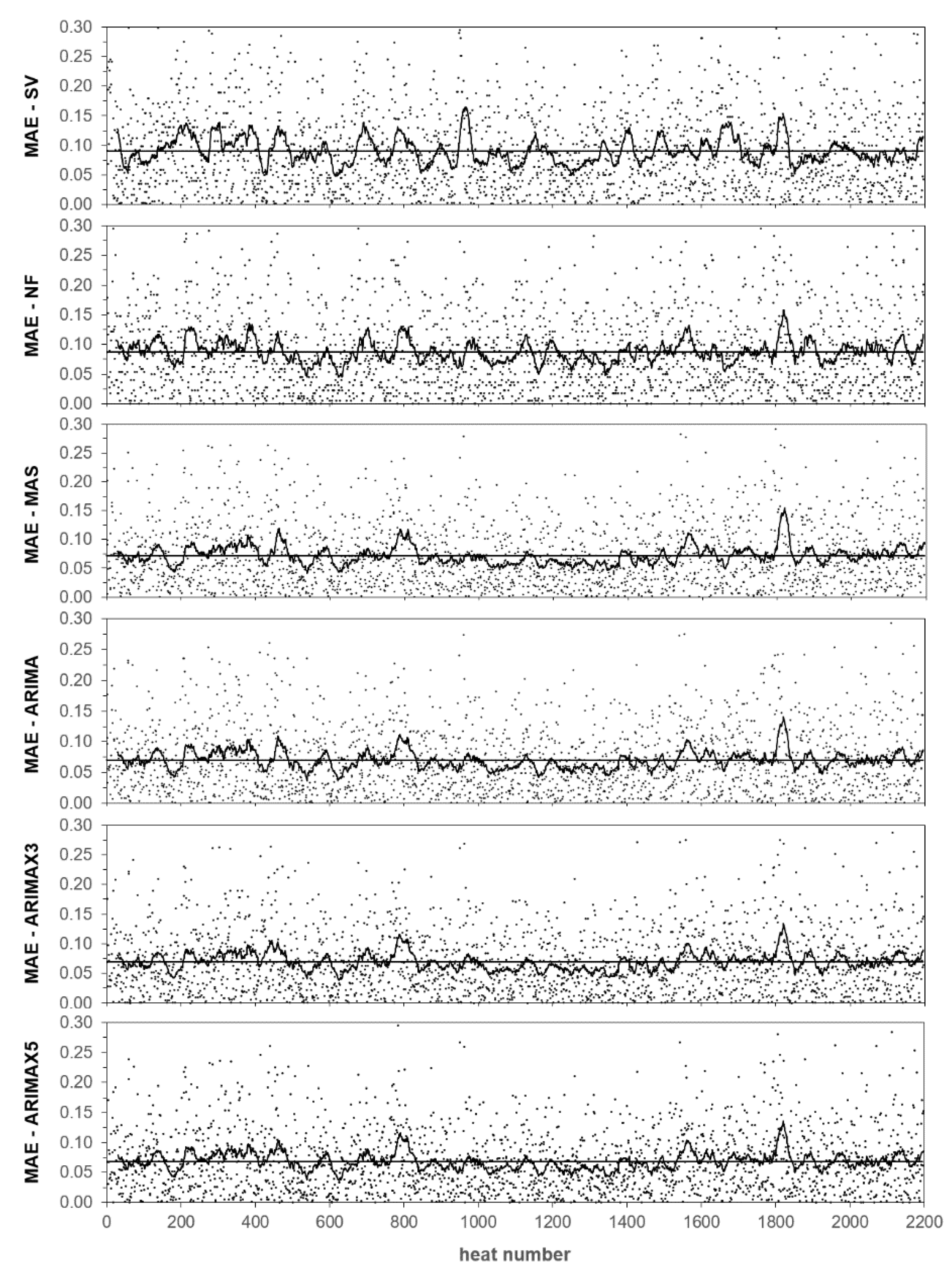Hot Metal Temperature Prediction at Basic-Lined Oxygen Furnace (BOF) Converter Using IR Thermometry and Forecasting Techniques
Abstract
:1. Introduction
2. Materials and Methods
2.1. Infrared Thermometry
2.2. Time Series Forecasting
2.2.1. Variable Selection and Normalization
2.2.2. Simple Reference Methods
2.2.3. Time Series Methods
3. Results
3.1. Infrared Thermometry
3.2. Time Series Forecasting
4. Discussion
4.1. Infrared Thermometry
4.2. Time Series Forecasting
- Hot metal pretreatment or unexpected changes in BF-BOF interface cannot be time-predicted
- Hot metal can arrive at the BOF in different order as tapped in BF (shuffled data)
- Hot metal can arrive at the BOF from different BFs (mixed data)
- Hot metal from a BF can go to another BOF or just be poured into a pit (unnoticed missing data)
- Hot metal loaded to the BOF is actually a mix of hot metal with different process history (time averaged data)
4.3. Combined Process and Model Development
5. Conclusions
Author Contributions
Funding
Acknowledgments
Conflicts of Interest
References
- Ghosh, A.; Chatterjee, A. Iron Making and Steelmaking: Theory and Practice; PHI Learning Pvt. Ltd.: New Delhi, India, 2008. [Google Scholar]
- Miller, T.W.; Jimenez, J.; Sharan, A.; Goldstein, D.A. Oxygen Steelmaking Processes. In The Making, Shaping, and Treating of Steel, 11th ed.; Fruehan, R.J., Ed.; The AISE Steel Foundation: Pittsburgh, PA, USA, 1998; pp. 475–524. [Google Scholar]
- Ryman, C.; Larsson, M. Reduction of CO2 emissions from integrated steelmaking by optimised scrap strategies: Application of process integration models on the BF–BOF system. ISIJ Int. 2006, 46, 1752–1758. [Google Scholar] [CrossRef]
- Ryman, C.; Larsson, M. Adaptation of process integration models for minimisation of energy use, CO2-emissions and raw material costs for integrated steelmaking. Chem. Eng. Trans. 2007, 12, 495–500. [Google Scholar]
- Jiménez, J.; Mochón, J.; de Ayala, J.S.; Obeso, F. Blast furnace hot metal temperature prediction through neural networks-based models. ISIJ Int. 2004, 44, 573–580. [Google Scholar] [CrossRef]
- Martín, R.D.; Obeso, F.; Mochón, J.; Barea, R.; Jiménez, J. Hot metal temperature prediction in blast furnace using advanced model based on fuzzy logic tools. Ironmak. Steelmak. 2007, 34, 241–247. [Google Scholar] [CrossRef]
- Jiang, Z.H.; Pan, D.; Gui, W.H.; Xie, Y.F.; Yang, C.H. Temperature measurement of molten iron in taphole of blast furnace combined temperature drop model with heat transfer model. Ironmak. Steelmak. 2018, 45, 230–238. [Google Scholar] [CrossRef]
- Sugiura, M.; Shinotake, A.; Nakashima, M.; Omoto, N. Simultaneous Measurements of Temperature and Iron–Slag Ratio at Taphole of Blast Furnace. Int. J. Thermophys. 2014, 35, 1320–1329. [Google Scholar] [CrossRef]
- Pan, D.; Jiang, Z.; Chen, Z.; Gui, W.; Xie, Y.; Yang, C. Temperature Measurement Method for Blast Furnace Molten Iron Based on Infrared Thermography and Temperature Reduction Model. Sensors 2018, 18, 3792–3806. [Google Scholar] [CrossRef]
- Pan, D.; Jiang, Z.; Chen, Z.; Gui, W.; Xie, Y.; Yang, C. Temperature Measurement and Compensation Method of Blast Furnace Molten Iron Based on Infrared Computer Vision. IEEE Trans. Instrum. Meas. 2018, 1–13. [Google Scholar] [CrossRef]
- Usamentiaga, R.; Molleda, J.; Garcia, D.F.; Granda, J.C.; Rendueles, J.L. Temperature measurement of molten pig iron with slag characterization and detection using infrared computer vision. IEEE Trans. Instrum. Meas. 2012, 61, 1149–1159. [Google Scholar] [CrossRef]
- Usamentiaga, R.; Venegas, P.; Guerediaga, J.; Vega, L.; Molleda, J.; Bulnes, F. Infrared thermography for temperature measurement and non-destructive testing. Sensors 2014, 14, 12305–12348. [Google Scholar] [CrossRef]
- Jin, S.; Harmuth, H.; Gruber, D.; Buhr, A.; Sinnema, S.; Rebouillat, L. Thermomechanical modelling of a torpedo car by considering working lining spalling. Ironmak. Steelmak. 2018, 1–5. [Google Scholar] [CrossRef]
- Nabeshima, Y.; Taoka, K.; Yamada, S. Hot metal dephosphorization treatment in torpedo car. Kawasaki Steel Tech. Rep. 1991, 24, 25–31. [Google Scholar]
- Frechette, M.; Chen, E. Thermal insulation of torpedo cars. In Proceedings of the Association for Iron and Steel Technology (Aistech) Conference Proceedings, Charlotte, NC, USA, 9–12 May 2005. [Google Scholar]
- Goldwaser, A.; Schutt, A. Optimal torpedo scheduling. J. Artif. Intell. Res. 2018, 63, 955–986. [Google Scholar] [CrossRef]
- Wang, G.; Tang, L. A column generation for locomotive scheduling problem in molten iron transportation. In Proceedings of the 2007 IEEE International Conference on Automation and Logistics, Jinan, China, 18–21 August 2007. [Google Scholar]
- Verdeja, L.F.; Barbes, M.F.; Gonzalez, R.; Castillo, G.A.; Colas, R. Thermal modelling of a torpedo-car. Rev. Metal. Madrid 2005, 41, 449–455. [Google Scholar] [CrossRef] [Green Version]
- Niedringhaus, J.C.; Blattner, J.L.; Engel, R. Armco’s Experimental 184 Mile Hot Metal Shipment. In Proceedings of the 47th Ironmaking Conference, Toronto, ON, Canada, 17–20 April 1988. [Google Scholar]
- He, F.; He, D.F.; Xu, A.J.; Wang, H.B.; Tian, N.Y. Hybrid model of molten steel temperature prediction based on ladle heat status and artificial neural network. J. Iron Steel Res. Int. 2014, 21, 181–190. [Google Scholar] [CrossRef]
- Du, T.; Cai, J.J.; Li, Y.J.; Wang, J.J. Analysis of Hot Metal Temperature Drop and Energy-Saving Mode on Techno-Interface of BF-BOF Route. Iron Steel 2008, 43, 83–86, 91. [Google Scholar]
- Liu, S.W.; Yu, J.K.; Yan, Z.G.; Liu, T. Factors and control methods of the heat loss of torpedo-ladle. J. Mater. Metall. 2010, 9, 159–163. [Google Scholar]
- Wu, M.; Zhang, Y.; Yang, S.; Xiang, S.; Liu, T.; Sun, G. Analysis of hot metal temperature drop in torpedo car. Iron Steel 2002, 37, 12–15. [Google Scholar]
- Ares, R.; Balante, W.; Donayo, R.; Gómez, A.; Perez, J. Getting more steel from less hot metal at Ternium Siderar steel plant. Rev. Metall. 2010, 107, 303–308. [Google Scholar] [CrossRef]
- Bradarić, T.D.; Slović, Z.M.; Raić, K.T. Recent experiences with improving steel-to-hot-metal ratio in BOF steelmaking. Metall. Mater. Eng. 2016, 22, 101–106. [Google Scholar] [CrossRef] [Green Version]
- Díaz, J.; Fernández, F.J. The Impact of Hot Metal Temperature on CO2 Emissions from BOF Steelmaking. Proceedings 2018, 2, 1502. [Google Scholar] [CrossRef]
- Kozlov, V.; Malyshkin, B. Accuracy of measurement of liquid metal temperature using immersion thermocouples. Metallurgist 1969, 13, 354–356. [Google Scholar] [CrossRef]
- Mazumdar, D.; Evans, J.W. Elements of mathematical modeling. In Modeling of Steelmaking Processes, 1st ed.; CRC Press: Boca Raton, FL, USA, 2010; pp. 139–173. [Google Scholar]
- Sickert, G.; Schramm, L. Long-time experiences with implementation, tuning and maintenance of transferable BOF process models. Rev. Metall. 2007, 104, 120–127. [Google Scholar] [CrossRef]
- Geerdes, M.; Toxopeus, H.; van der Vliet, C. Casthouse Operation. In Modern Blast Furnace Ironmaking: An Introduction, 1st ed.; Verlag Stahleisen GmbH: Düsseldorf, Germany, 2015; pp. 97–103. [Google Scholar]
- Williams, R.V. Control of oxygen steelmaking. In Control and Analysis in Iron and Steelmaking, 1st ed.; Butterworth Scientific Ltd.: London, UK, 1983; pp. 147–176. [Google Scholar]
- Hyndman, R.J.; Athanasopoulos, G. The forecaster’s toolbox. In Forecasting: Principles and Practice, 2nd ed.; OTexts: Melbourne, Australia, 2018; pp. 47–81. [Google Scholar]
- Papacharalampous, G.A.; Tyralis, H.; Koutsoyiannis, D. Comparison of stochastic and machine learning methods for multi-step ahead forecasting of hydrological processes. Stoch. Env. Res. Risk A 2019, 33, 481–514. [Google Scholar] [CrossRef]
- Hyndman, R.J.; Athanasopoulos, G. ARIMA models. In Forecasting: Principles and Practice, 2nd ed.; OTexts: Melbourne, Australia, 2018; pp. 221–274. [Google Scholar]
- Box, G.E.; Jenkins, G.M.; Reinsel, G.C.; Ljung, G.M. Model identification. In Time Series Analysis: Forecasting and Control, 5th ed.; John Wiley & Sons, Inc.: Hoboken, NJ, USA, 2015; pp. 179–208. [Google Scholar]
- ARIMA. Model Including Exogenous Covariates. Available online: https://es.mathworks.com/help/econ/arima-model-including-exogenous-regressors.html (accessed on 20 July 2019).
- Mihalow, F.A. Radiation thermometry in the steel industry. In Theory and Practice of Radiation Thermometry, 1st ed.; DeWitt, D.P., Nutter, G.D., Eds.; John Wiley & Sons, Inc.: Hoboken, NJ, USA, 1988. [Google Scholar]
- Tresp, V.; Hofmann, R. Nonlinear time-series prediction with missing and noisy data. Neural Comput. 1998, 10, 731–747. [Google Scholar] [CrossRef] [PubMed]
- McLean, A. The science and technology of steelmaking—Measurements, models, and manufacturing. Metall. Mater. Trans. B 2006, 37, 319–332. [Google Scholar] [CrossRef]
- Szekely, J. The mathematical modeling revolution in extractive metallurgy. Metall. Trans. B 1988, 19, 525–540. [Google Scholar] [CrossRef]
- Díaz, J.; Fernandez, F.J.; Gonzalez, A. Prediction of hot metal temperature in a BOF converter using an ANN. In Proceedings of the IRCSEEME 2018: International Research Conference on Sustainable Energy, Engineering, Materials and Environment, Mieres, Spain, 25–27 July 2018. [Google Scholar]









| Variable | Original | Normalized | |||
|---|---|---|---|---|---|
| Symbol | Min | Max | Unit | ||
| Initial temperature | T0 | 1400 | 1540 | °C | x1 |
| Elapsed time | t | 2 | 20 | h | x2 |
| Desulfurization time | td | 0 | 40 | min | x3 |
| Empty torpedo time | tc | 1 | 16 | h | x4 |
| Empty ladle time | tl | 0 | 8 | h | x5 |
| Final temperature | T | 1200 | 1420 | °C | y |
| Summary Statistic | CT | CL | R2 (CT, CL) | R2 (CT = 0, CL = 0) |
|---|---|---|---|---|
| Mean | 0.0 | 1.0 | 0.75 | 0.60 |
| Mode | 1.2 | 1.0 | 0.73 | 0.50 |
| Median | 0.2 | 1.5 | 0.69 | 0.47 |
| Percentile 75 | 0.9 | 0.8 | 0.77 | 0.70 |
| Percentile 85 | 1.0 | 0.9 | 0.80 | 0.70 |
| Percentile 95 | 1.0 | 0.9 | 0.80 | 0.71 |
| Maximum | 1.2 | 0.6 | 0.70 | 0.52 |
| Method | MAE | Minimum Required w | Number of Input Variables | Reliability (%) | Running Time (s) | Earliest Run in Advance (min) |
|---|---|---|---|---|---|---|
| SV | 0.0910 | 0 | 0 | 100 | - | Inf. |
| NF | 0.0875 | 1 | 1 | 99 | 0.001 | 10 |
| MAS | 0.0721 | 5 | 1 | 98 | 0.001 | 10 |
| ARIMA | 0.0700 | 100 | 1 | 95 | 0.671 | 10 |
| ARIMAX3 | 0.0695 | 250 | 4 | 92 | 1.051 | 10 |
| ARIMAX5 | 0.0685 | 300 | 6 | 91 | 1.396 | 10 |
| IR | 0.0500 | 1 | 1 | 60 | - | −10 |
© 2019 by the authors. Licensee MDPI, Basel, Switzerland. This article is an open access article distributed under the terms and conditions of the Creative Commons Attribution (CC BY) license (http://creativecommons.org/licenses/by/4.0/).
Share and Cite
Díaz, J.; Fernández, F.J.; Suárez, I. Hot Metal Temperature Prediction at Basic-Lined Oxygen Furnace (BOF) Converter Using IR Thermometry and Forecasting Techniques. Energies 2019, 12, 3235. https://doi.org/10.3390/en12173235
Díaz J, Fernández FJ, Suárez I. Hot Metal Temperature Prediction at Basic-Lined Oxygen Furnace (BOF) Converter Using IR Thermometry and Forecasting Techniques. Energies. 2019; 12(17):3235. https://doi.org/10.3390/en12173235
Chicago/Turabian StyleDíaz, José, Francisco Javier Fernández, and Inés Suárez. 2019. "Hot Metal Temperature Prediction at Basic-Lined Oxygen Furnace (BOF) Converter Using IR Thermometry and Forecasting Techniques" Energies 12, no. 17: 3235. https://doi.org/10.3390/en12173235





